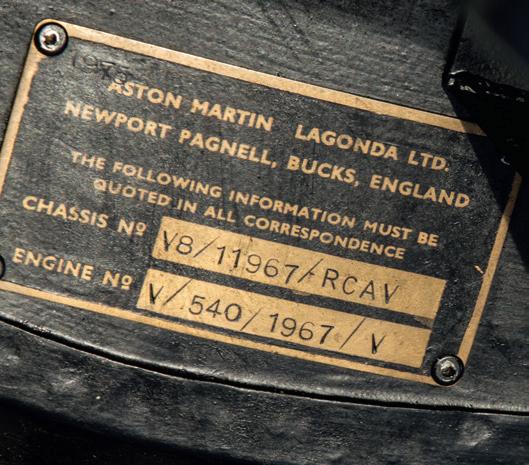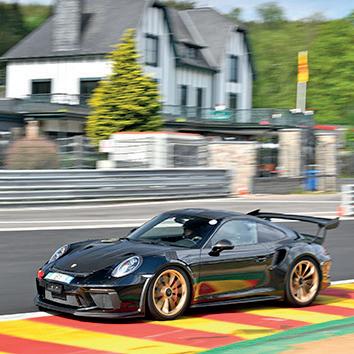
5 minute read
The many lives of VNKy
The long-lived development car for the V8 Vantage and Zagato project could soon be up for sale. Here’s its story
TAKE A CLOSE LOOK AT THE Vantage you see here – seems a bit, well, odd, doesn’t it? Yet there’s a reason for the stubbier demeanour and Speedline wheels from an Aston Martin Zagato – it’s the engineering mule for that very car. However, its life as a development hack began when the Z machine wasn’t even a twinkle in Peter Livanos’s eye.
It wasn’t supposed to be this way, as its owner, ‘Dr Ulrich’, explains: “It was one of the early flip-tail Vantages – one of the first 50 – and a customer car, built to RHD specification,” he says. “The original owner didn’t like it because it kept overheating.”
VNK 360S, chassis no. V8/11967/ RCAV, was thus bought back by the factory and thrust into action as a development hack. That action, according to notes from the development logbook, included breaking the front spoiler on an errant rabbit in 1982. The car also spent seven months at Piper to develop the fuel-injection system from 1983 onwards, and it trialled an electric vacuum-pump braking system, too. However, the tester did wonder if he’d even switched the pump on when he experienced poor braking performance.
The most drastic change was for the V8 Zagato project, for which ‘VNKy’ was used to develop the engine in the UK. “They brought it down to the weight of the Zagato, 200kg less than a normal Vantage,”
With subtle styling variations along with an experimental engine, this is a very special Aston.
Ulrich says. “They removed the aircon, sound-deadening and rear seats, and put in a smaller fuel tank.”
The engine produced 437bhp at 6250rpm, matched to a low-ratio diff that allowed the car to do 0-60mph without changing gear. Not only did it outperform the standard Vantage, but it was also quicker than the production Zagato cars. Its V8 has a very special claim to fame: “It’s an experimental engine, with a plaque on the cylinder-head covers that says it was built by the engineering department,” Ulrich says. “That’s because it was the engine used in the prototype Zagato that did the highspeed run at Le Mans with Roy Salvadori – it was supposed to reach 300km/h, but didn’t due to a blocked breather valve in the fuel system.”

That car was then used by José Rosinski of France’s L’Auto Journal on an autoroute on July 8, 1986, where it reached 298.75km/h. After that, a new engine was built for the Zagato prototype, and the 298.75km/h unit was reworked and put into VNKy.
While the lessons learned from the Zagato programme would influence the later X-Pack upgrades, by this point avowed Aston fans began to learn of a mysterious lightweight Vantage, and asked for replicas. The engineering team’s desire to take it racing was also a distraction. By early 1989, Aston had sold the car to a loyal customer, Wensley Haydon-Baillie.
“Until the early 1990s it was displayed at the Haydon-Baillie Aircraft and Naval Museum,” says Ulrich. Then it went to Aston Martin Owners Club (AMOC) member Bill Goodall, who started competing with it. After he sold it, the car was involved in a crash for which the recovery apparently caused more damage than the original accident.

Once repaired, another AMOC member raced it with success at various club sprints and hillclimbs. VNKy then headed to Australia, before surfacing in the US in 2003.
Ulrich bought the car in 2015 and, although he lives in Germany, he registered it in the UK to retain its special numberplate; he used to own five other Vantages, all with similar VNK plates in recognition of those issued in the Newport Pagnell area. While the engine, chassis and suspension have been refurbished, it still retains its original paint, the Zagato seats and NACA bonnet ducts.
However, Ulrich’s love affair with this Aston and his one other remaining Vantage, a left-hand-drive example, may be coming to an end.
“Because of all the modifications it’s had, and Brexit, I’m not allowed to drive it [in Germany] anymore,” he sighs. It’s clear he can’t really bear to part with it. “Modern cars are limited to 155mph, so passing an Audi A6 on the motorway because they can’t go any faster is impressive,” he chuckles. “As the English like to say, it goes like stink.”
Grenadier is on the attack
Hardcore new off-roader from INEOS aims to be a surefire hit with fans of traditional mud-plugging
IT’S TUESDAY MORNING IN the Scottish Highlands, and I am huddled around the warmth of a fire pit with a gaggle of fellow journalists. It’s bitingly cold. Snow has been falling relentlessly, and plumes of condensation rise from our coffee cups and out of our mouths.
The Narnia-like scenery couldn’t be any better for what lies ahead; the maiden adventure of the deliveryspecification INEOS Grenadier, a machine that has been six years and £700 million in the making.
It certainly looks the part. My allotted vehicle is a Trialmaster Edition, and it is finished in an agrarian shade of Sela Green. It looks completely at home covered in mud and snow in such a remote setting. Steel wheels, BFGoodrich tyres and a snorkel indicate that this car means business.
Snow crunches underfoot as I shuffle over to the driver’s door. I’m thankful the engine has been left running as I climb into the warm cabin. Inside, it’s clear that all the characterful utilitarianism promised by the prototypes remains intact.
The interior’s biggest talking point is the roof-mounted control panel that’s reminiscent of an aeroplane cockpit. The centre console is festooned with dials and switches that are modular and usefully chunky for my cold, gloved hands to operate, while the Recaro seats are supportive and comfortable. Ergonomically, it’s a great cabin, although the omission of heated seats seems a bit stingy for a model that starts at £59,000.
There’s no hiding the fact that the gear selector is from BMW. This, however, is no bad thing, because in ‘my’ car it’s connected to the Bavarian manufacturer’s excellent B57 3.0-litre straight-six diesel motor via a ZF eight-speed automatic transmission. With a bespoke ECU map, this produces 249bhp and a muscular 406lb ft of torque.
Our intrepid cavalcade puts those impressive numbers to good use. The all-terrain route begins on a narrow, craggy track glazed with ice and pockmarked by mud-plugged potholes and rocks. Lock the centre differential, engage the low-range ratios, and the INEOS off-roader resolutely forges onwards.
The going gets tougher when the
Grenadier’s slab of a nose is faced with climbing some steep, snowy inclines. Right on cue, my walkietalkie crackles into life and I’m instructed to lock the rear differential, squeeze the throttle pedal and keep the steering dead straight. I oblige, and the Grenadier determinedly hauls its 2600kg heft towards the summit.
Of course, what goes up must come down, so I enable the hilldescent control and grimace as I tease the Grenadier’s grille over the summit. Plucking up some courage, I remove my feet from the pedals and the INEOS slowly descends, the snowy ground filling the view through the windscreen.

As the punishing day comes to a close, it is clear that the Grenadier is just as capable as a classic Land Rover Defender. But there are a few niggles. Some of the switches feel flimsy, a lack of self-centring makes for frantic steering out of junctions, and interior storage is oddly meagre.

Even so, the Grenadier finds itself in an increasingly rarefied group of hardcore off-roaders. In short, it’s a triumph of mechanical simplicity and go-anywhere toughness.


















